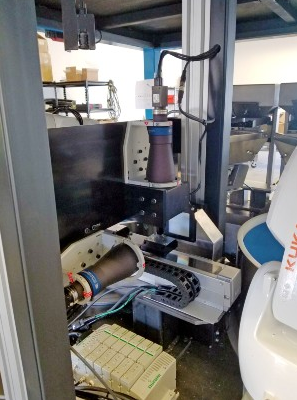In the automotive industry, different types of components are welded together in robotic welding cells during the production of cars. However,in case of incorrect or defective part assembly, the error cannot be corrected. Therefore, automotive suppliers need a machine vision-based solution that can inspect mixed models without requiring new hardware, additional floor space, or even new systems.

Skye Automation developed during the COVID-19 pandemic a flexible and adaptable solution for a Tier 2 automotive supplier. This system consists of industrial cameras, robots, flexible part feeders, and vision softwareand can inspect 15 different types of parts. For this dynamic part inspection, the operator chooses the correct recipe for each part type and defines the number of boxes to fill and the total number of parts to be examined. At the beginning of the process, components are moved from a magnetic feeder to a robotic work cell through two hoppers. After that, the parts enter into vibratory feeders and then into two programmable FlexiBowl feeders, which are responsible for the parts typeseparation.
In addition, the system is equipped with five VCXG – 51M 5 megapixel GigE cameras from Baumer, twofor component inspection,two for part localization in theFlexiBowl feeders, and one for barcode verification. Specifically, when acomponent enters the FlexiBowl and is separated, the corresponding cameras capture images in order to direct the manipulator properly. The robot collects the components and places them on the inspection table.After that, based on machine vision software, each partisoriented to a specific direction to be accepted or rejected. Parts either pass into a box that sits on a conveyor or go directly into a reject bin for disposal.When the box is filled with a predetermined amount of parts, it indexes up an elevator and rolls down a gravity-fed conveyor. Finally, the automation system places the next empty box in front of the load station.The elevator, the pusher, and the linear motor actuators of the automation system are controlled by a Programmable Logic Controller (PLC).After packing the box,an inkjet barcode printer directly prints codes onto the filled boxes. The fifth GigE camera reads the serial number to ensure the content of the boxes and that the barcodes match the current recipe running on the system.
The ever-increasing needs of today’s manufacturing environmentmake the integration of machine vision systems imperative in today’s industry in order to ensure higher product quality as well ascost reduction for the company itself.
The link to the source.
